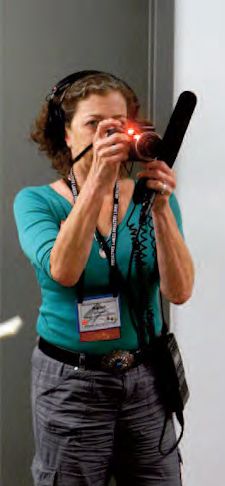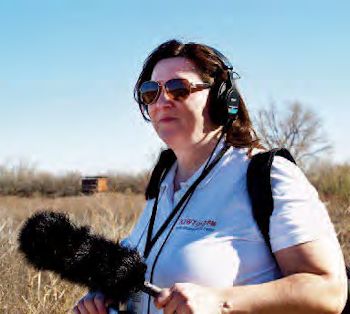SEJournal Online is the digital news magazine of the Society of Environmental Journalists. Learn more about SEJournal Online, including submission, subscription and advertising information.
SEJ News
By KAREN SCHAEFER and LANA STRAUB
SEJ's Mentor Program pairs veteran environmental reporters with less experienced SEJ members who want to improve their skills or learn new ones. But no two mentorships are alike. Mentor partners Karen Schaefer, an Ohio-based freelance journalist and independent radio producer, and Lana Straub, who is pursuing a similar career in Texas, offer their take on what a great mentoring experience can be.
 |
|
Karen Schaefer at work reporting with at least two tools of the trade on a field trip to the Oak Ridge National Laboratory during the 2013 SEJ conference in Chattanooga, Tennessee. Photo: © Roger Archibald |
Schaefer: What first caught my ear about Lana (remember we're both radio journalists) was her authentic West Texas accent – and her unusual take on a water quality story from her region. We were both at the freelance workshop held before the 2012 SEJ conference in Lubbock, and it was near the end of the day. I sashayed up and introduced myself – and met a remarkable young woman with a great nose for news who'd worked most of her career in print.
Straub: Karen impressed me right away with her directness. She immediately began asking questions about my experience in journalism and whether I had any interest in radio. Somewhere deep inside I did, but I didn't know where to start, and I didn't feel like I had the confidence to pursue it on my own.
Schaefer: Lana was immediately enthusiastic about giving radio journalism a try, and I offered to help. Soon we were messaging back and forth, with her asking astute questions about equipment and me answering them to the best of my ability. Before I knew it, Lana had landed an assignment from KXWT-West Texas public radio – and I was helping her craft her first story.
Straub: That first piece scared me to death. I remember walking into a press conference with Laura Bush – which I'd gotten into because of my blog "Water Tells" – carrying my little Olympus DS recorder and a set of earbuds. The looks on the faces of the "real" TV and radio journalists were priceless. But I stood there, bolstered by Karen's new confidence in me, and asked environmental questions of the former First Lady. And she answered them like I was one of the big leaguers.
Schaefer: Lana and I dealt with every public radio issue you can imagine, starting with windscreens for microphones (a necessity in West Texas) and how to gather ambient sound, then running through the whole radio reporting gamut – structuring stories, writing for the ear, even how you write out numbers in radio scripts so they can be easily read. By the early part of 2013, it was clear we had a partnership. I was already a volunteer mentor in SEJ's program. So I proposed we formalize our match.
Straub: Dawn Stover and Jane Braxton Little, who coordinate the SEJ mentoring program, quickly responded to my request for Karen as my mentor, and within days we were off and running in a formal mentor/mentee relationship. And Karen turned up the heat.
Schaefer: I find it hard to believe that more than a year has gone by since we began to work together. This wasn't my first mentorship for SEJ, but it's definitely been the most rewarding to date. Lana and I talked via Skype a few times, emailed and IM'ed frequently, and generally walked down every path a radio journalist-in-training needs to take. I think what worked for us best was the fact that we both respected work schedules and time zone differences, but were still willing to collaborate at odd hours to meet the demands of radio deadlines.
 |
|
Newcomer to radio reporting Lana Straub. Photo courtesy of Lana Straub |
Straub: Before I knew it, a year had gone by and I had aired more than 30 features on KXWT, most of them well over four minutes each. I had learned radio interviewing skills, script writing, production techniques, even how to do a two-way, as a radio host interviewing a reporter. I got full station credentials during that time period and even a raise, all because Karen saw potential in me I didn't see in myself.
Schaefer: I'm proud to say that Lana has, in just over a year, turned herself into a radio reporter prized not only by her station (which recently underwrote the costs of her multi-day participation in a Watchdog Reporting Workshop put on by IRE and the New England Center for Investigative Reporting in Fort Worth), but also by the larger journalism world. Lana was chosen this spring by the Institute for Journalism and Natural Resources for their recent Shale Country expedition, to learn the ropes of fracking issues that beset her native West Texas. We continue to communicate whenever she needs my help. I am working on setting her up with an NPR mentor now and firmly expect to hear her on NPR in the very near future.
Straub: I really enjoyed being part of the mentor program and would love to mentor someone myself. I think this is a valuable part of journalism organizations and that SEJ should talk it up at the conferences. We really need to connect older, more experienced SEJers with the younger groups. I also think that encouraging journalists to go beyond their comfort zone, from print to radio to television, is an important part of SEJ's future. Journalism is changing every day, especially environmental journalism, and SEJ can help its members find new and innovative ways to adjust to these changes. The mentor program is one way.
I started radio journalism at 41 years old – because Karen told me I could. The thought would never have crossed my mind, but she saw potential in me and she nurtured it. And now I have produced more than 30 pieces of radio journalism for my local station. Am I on NPR yet? No. Am I going to be before year's end? You betcha. With Karen's training, I know I am ready.
SEJ offers free one-on-one mentoring to any member seeking new skills, advice or critique. SEJ mentors are volunteers who have agreed to be contacted by a "mentee" at least four times during the course of a year. Although Karen and Lana initiated their own partnership, most matches begin with an introduction from volunteer program coordinators Jane Braxton Little and Dawn Stover. The mentor program is primarily designed for working professionals, but applications are also accepted from university-level students who have demonstrated a serious interest in environmental journalism. The program currently has about 100 mentors on its roster and more than 30 active partnerships. To apply as a mentor or mentee, fill out a short online application here. Experienced freelancers and investigative reporters are in particularly high demand as mentors, and are encouraged to apply.
* From the quarterly newsletter SEJournal, Fall 2014. Each new issue of SEJournal is available to members and subscribers only; find subscription information here or learn how to join SEJ. Past issues are archived for the public here.













 Advertisement
Advertisement 



